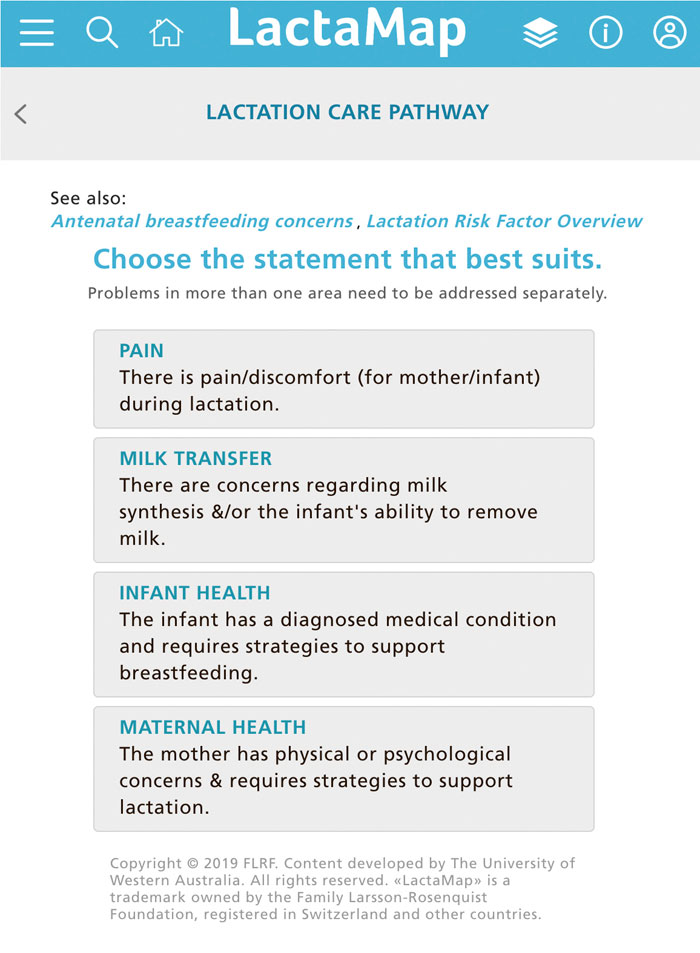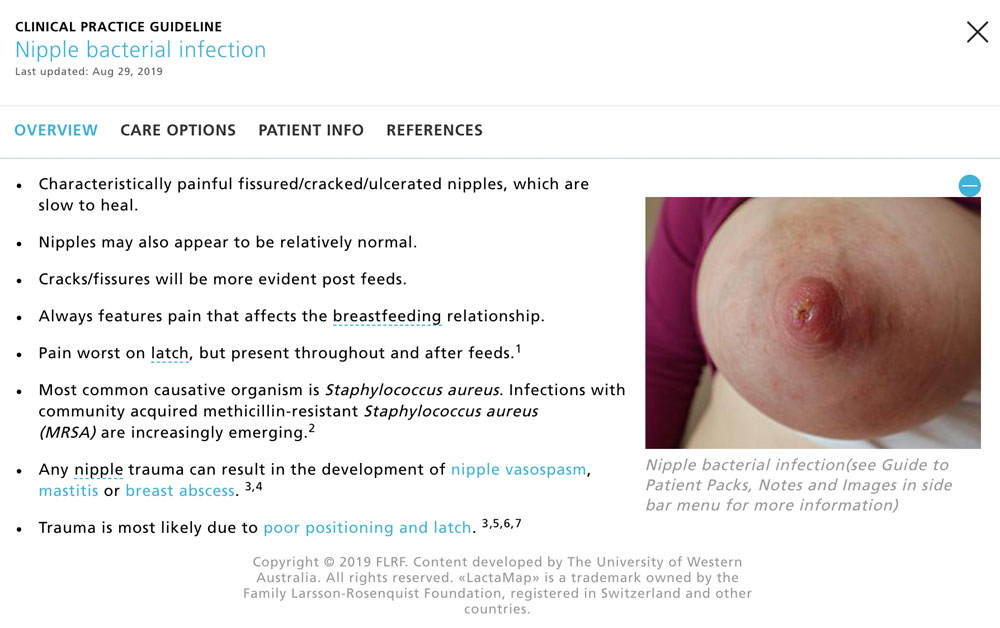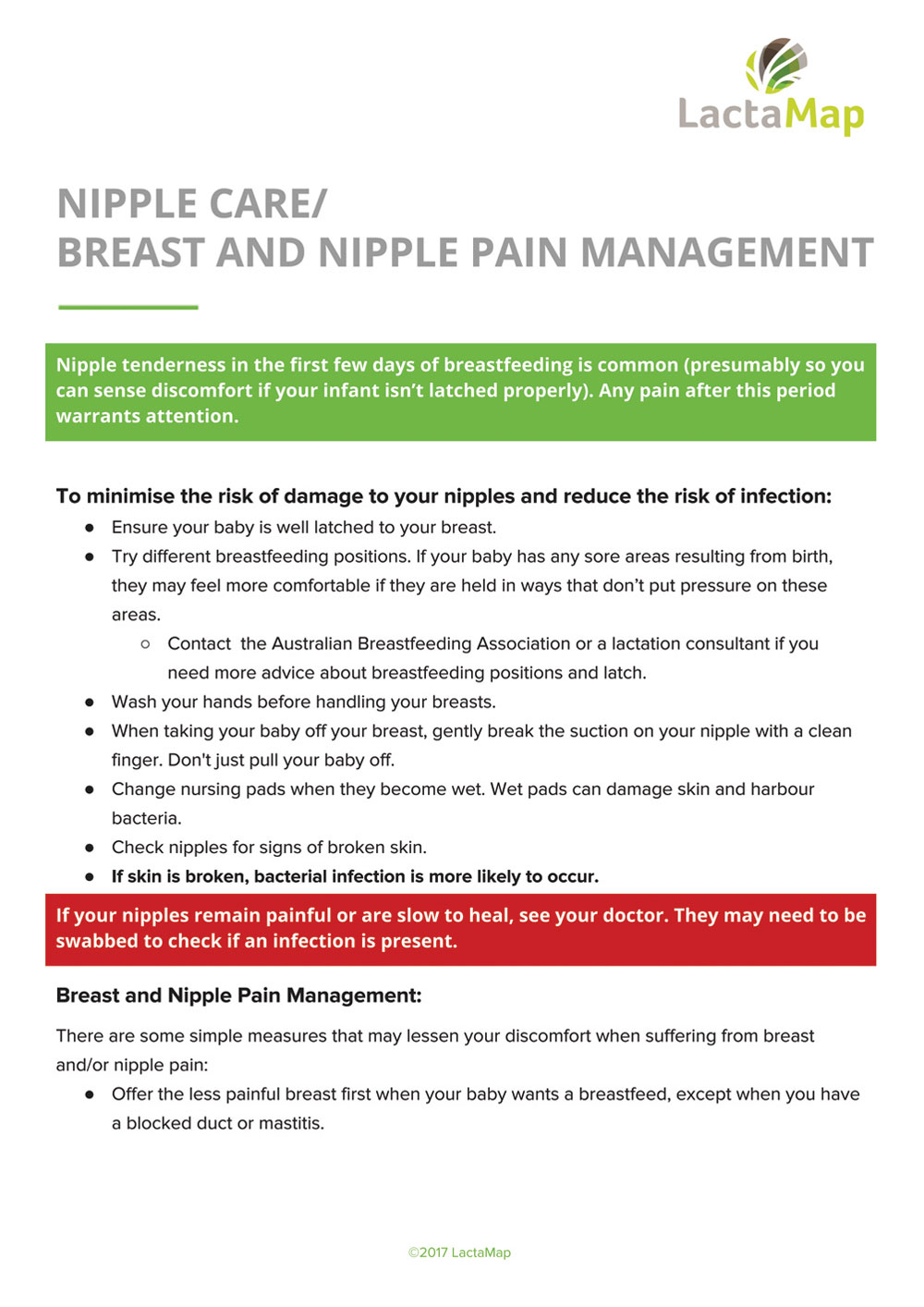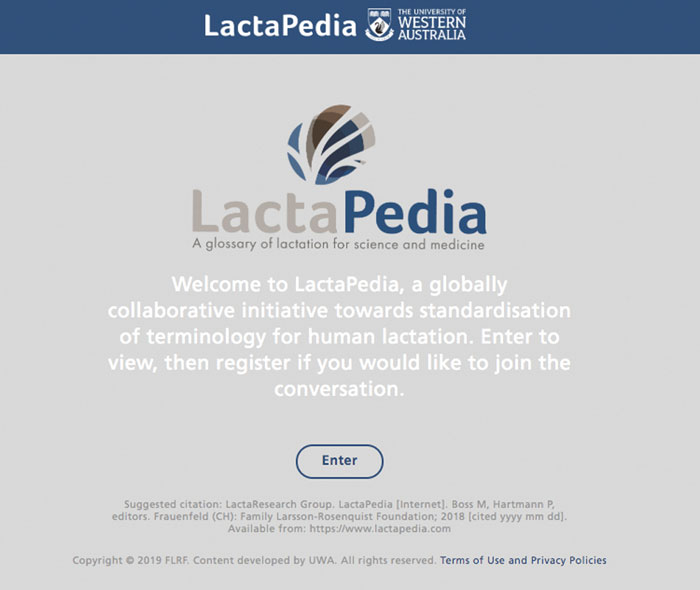LactaMap, an online lactation care support system
To improve the consistency of advice received by breastfeeding mothers and their infants, the LactaResearch group from The University of Western Australia has developed LactaMap. LactaMap is an online lactation care support system designed to provide doctors and other healthcare professionals with the evidence-base needed to care for women and infants experiencing difficulties with breastfeeding. It was developed for use during a medical consultation, so the online content is simple to navigate and aims to support the clinician to reach a decision point within seven minutes.
Melinda BossMothers commonly report inconsistentadvice from health professionals as a factor contributing to early cessation of breastfeeding.1,2 Incorporation of the knowledge gained from research (evidence) is recognised as the most effective way to promote consistency of treat-ment.3 Compared with other major organs such as the heart, brain, liver, lungs and kidneys, the lactating breast has been the subject of much less scientific investigation and there has been very little translation to medical care of the research that is available.4 Compounding this problem doctors, obstetricians, paediatricians and indeed most healthcare professionals are reporting that they are not receiving the lactation education for the knowledge and skills expected of them.5-7
LactaMap
To improve the consistency of advice received by breastfeeding mothers and their infants, the LactaResearch group from The University of Western Australia has developed LactaMap.8 LactaMap is an online lactation care support system designed to provide doctors and other healthcare professionals with the evidence-base needed to care for women and infants experiencing difficulties with breastfeeding. It was developed for use during a medical consultation, so the online content is simple to navigate and aims to support the clinician to reach a decision point within seven minutes.

FIGURE 1 The LactaMap lactation care pathway.
While LactaMap is simple to use, its strength is in its content. LactaMap is the result of 10 years of work from a multidisciplinary group that included doctors, a paediatrician, pharmacists, a child health nurse, lactation consultants, a midwife, a nutritionist and expert lactation researchers. It contains 112 clinical practice guidelines, as well as supporting information documents, patient information documents and normal function articles supported by more than 1,000 references. Methodology behind content development is documented in the LactaMap handbook, which is available for download from the website. Users can either search required content directly or travel down a decision tree that ends in a list of relevant clinical practice guidelines. The decision tree (lactation care pathway) is navigated in a few clicks, starting with consideration of four key areas (FIGURE 1):
- pain
- milk transfer
- infant health
- maternal health.
Once the statement that best suits has been selected, the clinician is prompted to consider a few simple questions in order to reach the relevant clinical practice guidelines for the presenting condition. In each guideline, content is referenced and linked to the PubMed citation wherever possible so users can access the original research if they want to. Photos of medical conditions are included if they have an objective test confirming the diagnosis. For example, a swab of the nipple shown in the guideline for nipple bacterial infection (FIGURE 2) yielded positive results for infection with Staphylococcus aureus and group B Streptococcus. Patient information documents for families are also included and can be emailed or printed out (FIGURE 3).

FIGURE 2 The LactaMap nipple bacterial infection clinical practice guideline showing an image of an infected nipple.
LactaPedia
During the development of such a large amount of content around lactation, it became clear that many terms had differing definitions in the scientific and medical literature. A common language is the most basic requirement for the prevention of inconsistent advice. Therefore a glossary was created to ensure consistency of terms in LactaMap. This glossary became LactaPedia (FIGURE 4).9 LactaPedia is available within LactaMap but is also a standalone website. It contains more than 560 terms and has been reviewed by five international experts in the field. The standalone website supports sharing, refinement and extension of the glossary via discussion forums allowing anyone to provide suggestions, comment or critique. This input is collated and assessed and the resulting updates to LactaPedia are planned to be published annually. The aim is that LactaPedia will become an international standard for lactation terminology.
LactaMap – features and use
An important feature of LactaMap is that not only is the content evidence-based, but LactaMap itself is research-based. Once the initial manuscripts for all clinical practice guidelines were completed, the AGREE II (Appraisal of Guidelines for Research and Evaluation) instrument was used to assess the methodology for their development and identify areas for improvement.10
The results of this study were used to improve methodology for ongoing update and review of the online LactaMap content.
This content update system allows the translation of new research to practice soon after publication, an improvement on the conventional process that has been widely quoted to take 17 years.11

FIGURE 3 An example of a LactaMap patient information document.

FIGURE 4 The welcome screen of LactaPedia.
Other studies are also being conducted to gain insight from the intended end users of LactaMap – doctors and mothers. A feasibility study was undertaken with doctors to investigate the usability and intuitiveness of the LactaMap user interface within the context of a medical consultation. This research resulted in improvements in functionality, including the ability to close images as some of these were noted to have the potential to be unpleasant for mothers. Another study is currently in progress to gain input from mothers regarding the patient information documents. These results will then be used to improve the information delivered to families.
LactaMap was globally launched on 26 March 2019 during a webinar for the Breastfeeding Innovations Team, hosted by Leith Greenslade (CEO JustActions, New York, USA). A LactaMap smartphone app is under development and will be available soon. Once downloaded, this will allow content to be accessible offline anywhere in the world.
The important health outcomes associated with lactation for both mothers and infants are well documented.12 Many of these health outcomes are dose-related, meaning the longer lactation is sustained the greater the effect. Although most mothers initiate breastfeeding, many are unable to sustain lactation for the minimum durations recommended by the World Health Organization (exclusive breastfeeding for the first six months, then continued breastfeeding during the introduction of appropriate, nutritious first foods until two years of age and beyond). The prevalence of most breastfeeding indicators decreases with increasing national wealth. By the time they reach 12 months of age less than 20% of infants from high-income countries are breastfed.12 It is hoped that LactaMap, which facilitates the integration of available scientific evidence with education at the point of care, together with psychological and practical support will help to improve the outcomes of breastfeeding women and their infants.
Acknowledgement
The support of the Family Larsson-Rosenquist Foundation is gratefully acknowledged (major sponsor) as well as the Rotary Club of Southern Districts.
LactaMap and LactaPedia are both available free of charge.
Or read this article in our
Tablet/iPad edition


